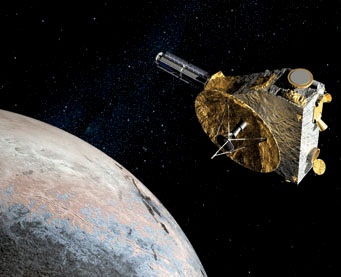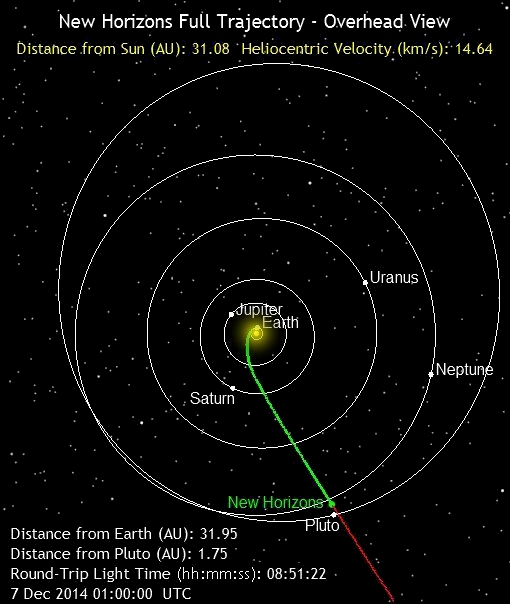Right on cue, New Horizons spacecraft has awakened from its final electronic hibernation. Seven months from now, it will make the first-ever visit to Pluto.

"Hello? New Horizons? C'mon, sleepy-head . . . it's time to get ready for your big date with Pluto!"
OK, today's actual wake-up sequence for NASA's Pluto-bound spacecraft was a little more involved than this, actually a set of commands already stored on-board in computer memory. But the result was the same.
Circuitry aboard New Horizons surged to life as the spacecraft emerged from electronic hibernation. The craft's transmitter dispatched a status report, but it didn't reach Earth for 4 hours 26 minutes (the one-way light time across a void of 4.8 billion km). The activation signal reached the mission's control center at the Johns Hopkins University's Applied Physics Laboratory at 9:53 p.m. EST.

NASA / JHU-APL / Satellite Tool Kit
In one sense, the awakening was routine. Launched on January 19, 2006, New Horizons took just 13 months to reach Jupiter (whose gravity provided a speed boost). Then it spent eight years crossing the orbits of Saturn, Uranus, and Neptune. It was put to sleep 18 times during that stretch, notes Alice Bowman, the mission operations manager at JHU-APL, for a total of 1,873 days (66% or its time in space). These dormant periods ranged from 36 to 202 days.
But this time it's different. From this point forward, the spacecraft will remain alert — and busy — until its historic flyby with the Pluto system next July 14th. Soon the craft will undergo a series of health checks and computer updates. Investigators here on Earth will also recover data on charged particles and interplanetary dust collected since August by three of seven on-board instruments as New Horizons silently drifted outward.
The spacecraft will get to work in several weeks, on January 15th, when regular observations of Pluto and its satellites begins. By May, its images of Pluto should exceed the resolution of the best ones taken to date by the Hubble Space Telescope. "Our knowledge of Pluto is quite meager," comments principal investigator Alan Stern (Southwest Research Institute. "We know very, very little about this world. In a real sense it's very much like our knowledge of Mars was before the first mission to Mars 50 years ago."
Read more about the mission and its objectives at the New Horizons website.
Plan your observing session for the next week or an entire year with the 2015 edition of the RASC's Observer's Handbook.
 1
1









Comments
December 8, 2014 at 10:55 am
Only seven months to go until New Horizons' closest approach to Pluto!!! I have already been waiting 44 years for this (ever since I first read that NASA's original "Grand Tour of the Outer Planets" mission was suppose to go to Pluto) and simply can not wait for July. But given how long it has taken New Horizons to be proposed, built, launched and fly to Pluto, it really isn't too early to start thinking about a follow on mission to this distant world especially given how its atmosphere evolves with the changes in season and distance from the Sun.
http://www.drewexmachina.com/2014/07/14/the-next-mission-to-pluto/
You must be logged in to post a comment.
You must be logged in to post a comment.